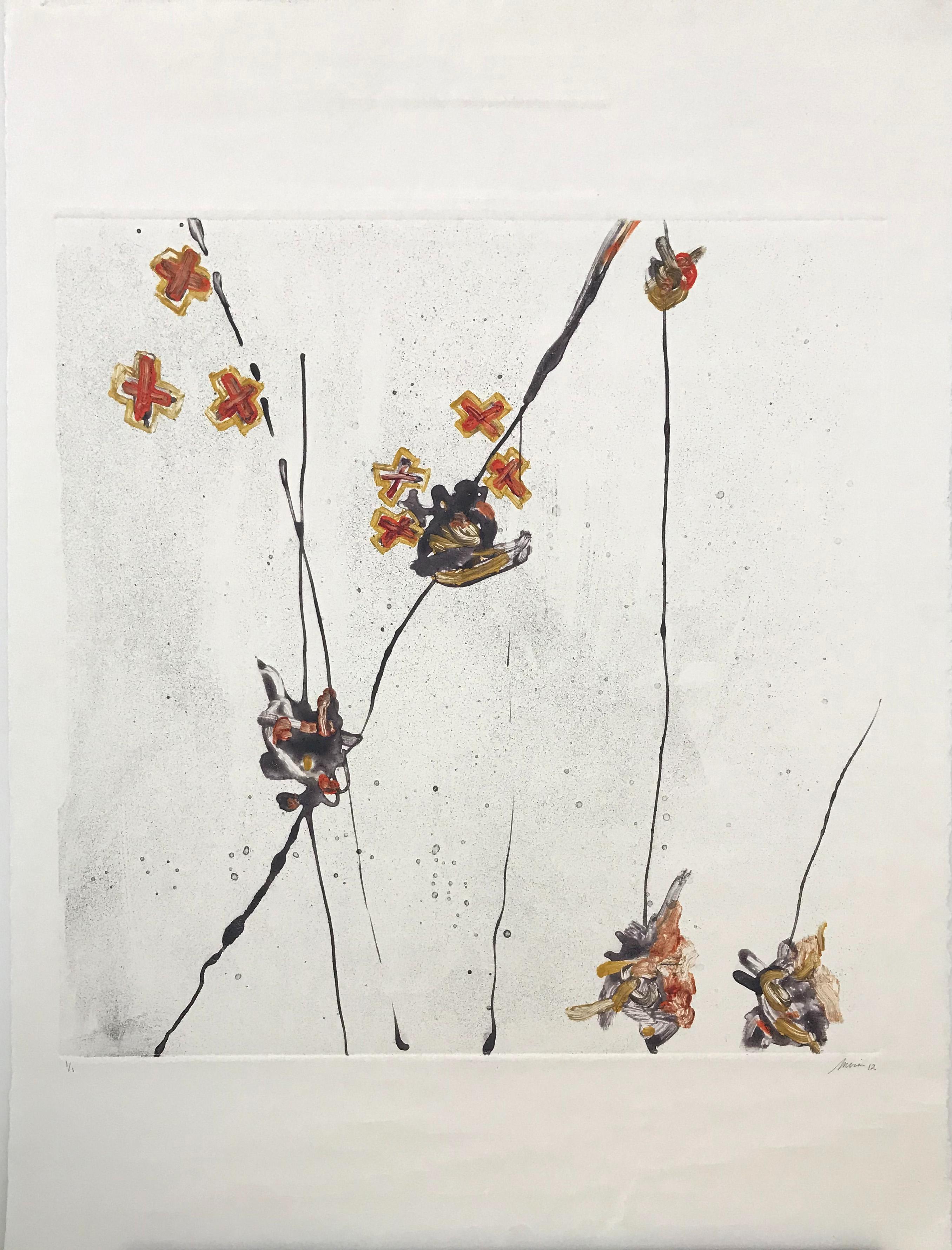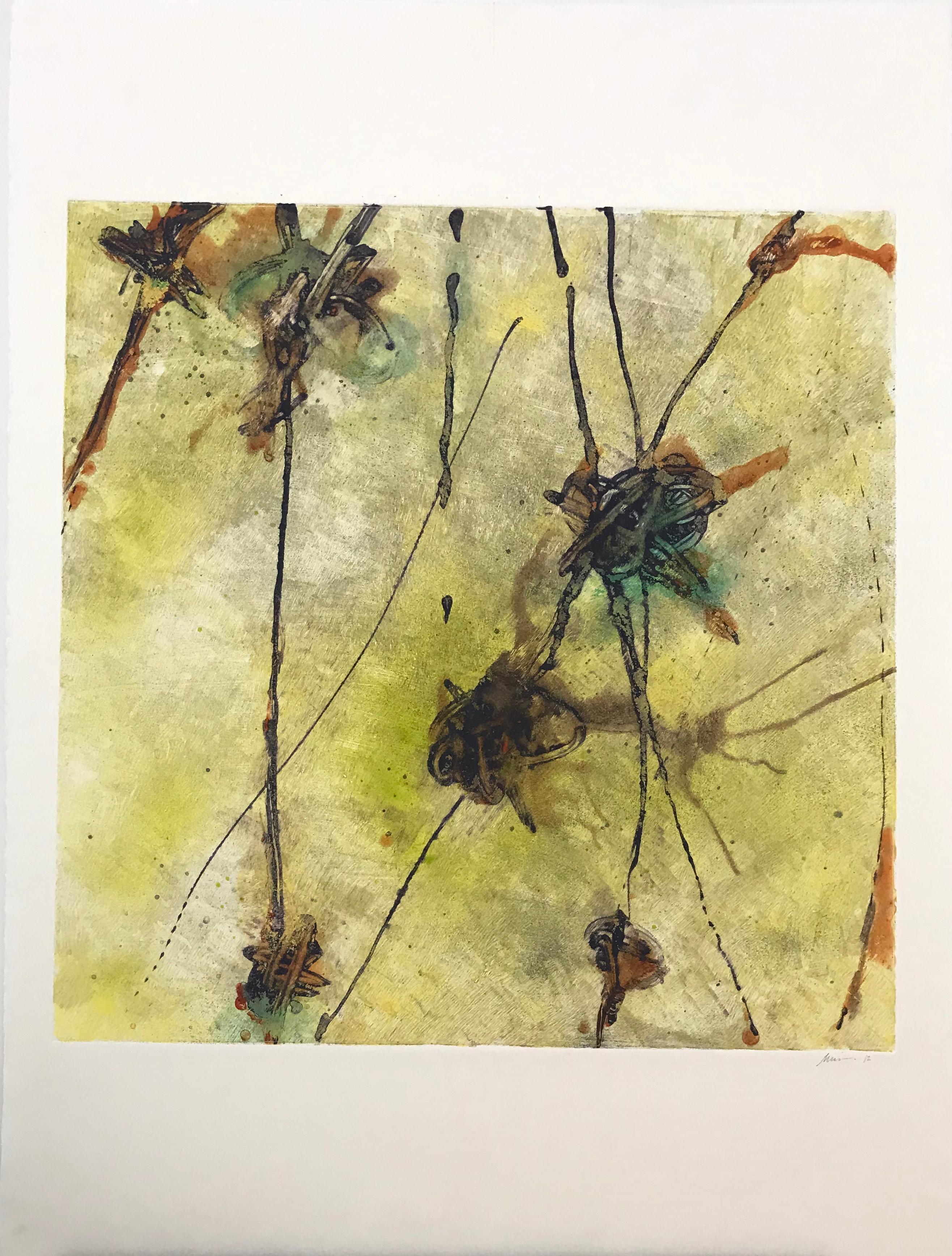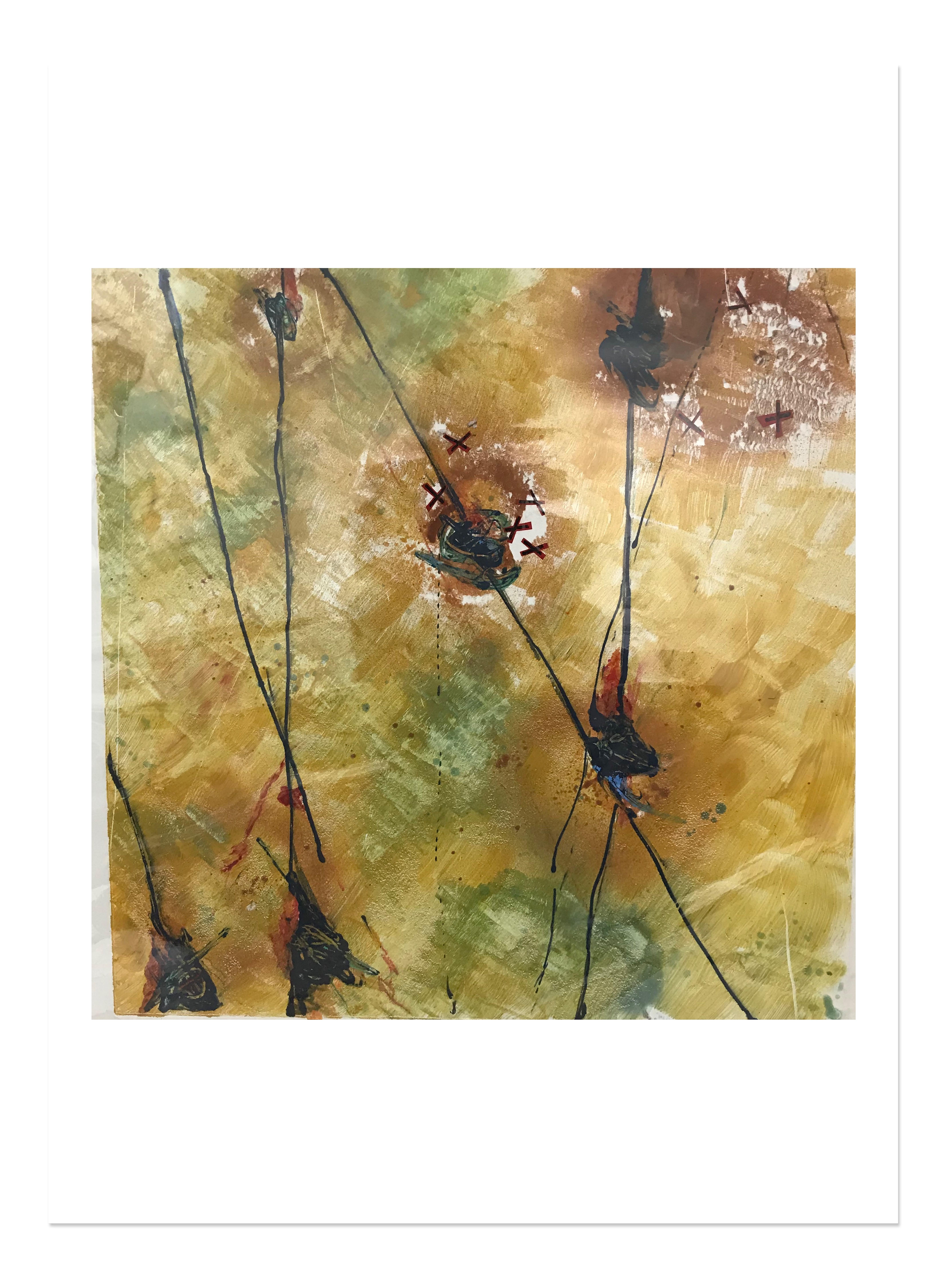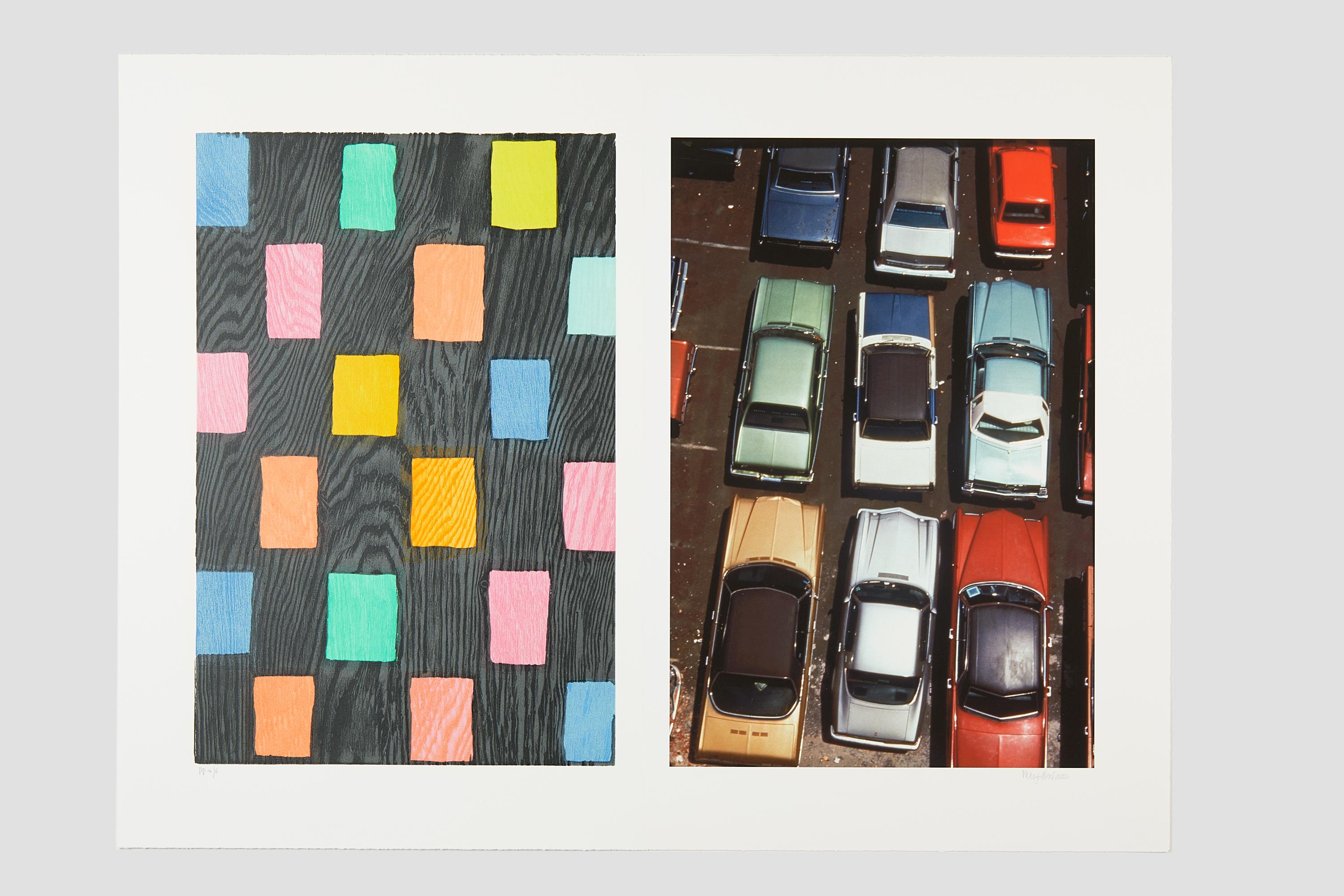Items Similar to Living Painting - Colour Pochoir
Want more images or videos?
Request additional images or videos from the seller
1 of 5
(after) Sonia DelaunayLiving Painting - Colour Pochoir1969
1969
About the Item
after Sonia Delaunay
Full-page, colour pochoir after costume designs by Sonia Delaunay
Edition 331/500 copies on Velin Aussedat
Dimensions: 28.5 x 19.5 cm.
From 27 Living Paintings. [Milano, Edizioni del Naviglio, 1969]. Jacques Damase. Robes Poèmes, Introduction. Text by Guillaume Apollinaire and Blaise Cendrars.
Sonia Delaunay was known for her vivid use of color and her bold, abstract patterns, breaking down traditional distinctions between the fine and applied arts as an artist, designer and printmaker.
Born Sarah Stern on November 14, 1885 in Gradizhsk, Ukraine, she was adopted in 1890 by her maternal uncle, Henri Terk, a lawyer in St. Petersburg, where she grew up, exposed to music and art, and learning several foreign languages. In 1903, she moved to Germany to study drawing with Ludwig Schmidt-Reutler (1863–1909) at the Karlsruhe academy of fine arts; Arnold Schoenberg (1874–1951), composer-to-be, was among her classmates there. In 1905, she traveled to Paris where she attended art classes at the Académie de la Palette, learned printmaking from Rudolf Grossman (1889–1941), and met Amédée Ozenfant (1886–1966), André Dunoyer de Segonzac (1884–1974), and Jean-Louis Boussingault (1883–1943). Sonia spent much of her time at exhibitions and galleries in Paris, which showed works by Paul Cézanne, Vincent Van Gogh, Pierre Bonnard, and Edouard Vuillard, as well as Les Fauves, Henri Matisse and André Derain. She did, however, maintain contact with Germany, exhibiting at the Galerie Der Sturm, Berlin, in 1913, 1920 and 1921.
During her first year in Paris, Sonia met the German collector and art-dealer, Wilhelm Uhde (1874–1947), whom she married on December 5, 1908, and whose Montparnasse gallery, the Galerie Notre-Dame des Champs, showed her first solo exhibition. Through Uhde, Sonia encountered many painters, including Pablo Picasso, Georges Braque, Maurice de Vlaminck, and Robert Delaunay (1885–1941). In 1910, Sonia divorced Uhde by mutual agreement, married Delaunay that same year, and gave birth to their son, Charles, in January 1911.
Together Sonia and Robert Delaunay pursued the study of color, influenced by theories of Michel-Eugène Chevreul (1786–1889). Sonia’s interest in simultaneous contrast, as evidenced in her early collages, book bindings, small painted boxes, cushions, waistcoats and lampshades, led to one of her first large-scale works, the painting of the Bal Bullier (1912–1913), a popular Parisian dance-hall. Sonia’s first “simultaneous dresses,” a mix of squares and triangles of taffeta, tulle, flannelette, moiré, and corded silk, date from this period.
Friendship with the poet Blaise Cendrars (1887–1961) resulted in Sonia’s colored-squares fabric binding for his poem Pâques à New York (1912), and her collaboration on an accordion-type book of Cendrars’ long 207 verse poem, La Prose du Transsibérien et de la Petite Jehanne de France (1913), whose unique format, a vertical scroll almost two meters long, is said to have been inspired by the Delaunays’ fascination with the Eiffel Tower. Other aspects of modern urban life that inspired Sonia’s work included electric street lights (Prismes électriques, 1914) and publicity, though the various studies that she did for projects for Chocolat, Zenith, and Le Rêve gas stoves all remained unrealized.
When World War I was declared in 1914, Sonia Delaunay was in the Basque border town of Fuenterrabía with her husband, and they did not return to Paris until 1920. During this period, they traveled to Madrid and to the village of Vila do Condo in Portugal, and Valença da Minho, where she painted still-lifes and market scenes. While in Madrid, she had become interested in Flamenco singers, and continued to do versions of this subject in Portugal (Flamenco Singer, 1916). Sonia Delaunay claimed that living in the Iberian Peninsula had opened her eyes to the very origin of light.
Settled in Madrid, she started to engage in interior decoration (Casa Sonia) in addition to designing clothes and costumes. In 1918, Serge Diaghilev (1872–1929) commissioned her to do the costumes for a Ballets Russes production of Cléopatre, which opened in London. The soprano Aga Lahovska persuaded Delaunay to design the costumes for a production of the opera Aida at the Liceo in Barcelona. Following the Aida, she was invited to decorate a new nightclub, the Petit Casino, scheduled to open in a remodeled theatre in Madrid. She virtually gave up painting between 1918 and 1935 when she lost the financial support of her relatives in St. Petersburg with the outbreak of the Russian Revolution in 1917.
When Sonia and Robert Delaunay returned to Paris in 1920, they took an apartment at 19 boulevard Malesherbes, which Sonia completely redecorated with furniture that she designed herself—most pieces now in the Musée des Arts Décoratifs in Paris. The Delaunay home was open to members of Dada and Surrealist groups: Tristan Tzara (1896–1963), Philippe Soupault (1897–1990), André Breton (1896–1982), Louis Aragon (1897–1982), René Crevel (1900–1935), etc. Delaunay’s friendship with Tzara lasted more than forty years: they launched the famous ‘poem-dresses’ (words and colors in ever new relationships through body movement), and in July 1923 Delaunay designed the costumes for Tzara’s play, Coeur à gaz, which was produced as part of an evening of experimental theatre, with music by Georges Auric (1899–1983), and Crevel in one of the parts.
Delaunay’s involvement in fabrics began as early as 1923 with the more than fifty designs that she provided a silk manufacturer in Lyon. In 1924, she founded her own company with four directors, among them the prominent couturier and furrier, Jacques Heim (1899–1967). Her greatest success came in 1925, at the Exposition Internationale des Arts Décoratifs et Industriels Modernes, for which she designed and decorated her Boutique Simultanée, run with the help of Heim.
Sonia Delaunay was extraordinarily prolific up to the 1930 world Depression; her work became known in London at Liberty’s and in department stores in New York, not to mention her profitable collaboration with the Amsterdam department store of Metz & Co., begun in 1925. She was designing not only fabrics and fashion, but carpets and panels and handbags, and also costumes for two films: Vertige, directed by Marcel L’Herbier (1888–1979), and Le p’tit Parigot by René Le Somptier (both 1926). Her renown for her fabrics and clothing brought her an invitation to speak at the Sorbonne, January 27, 1927, on “The Influence of Painting on the Art of Clothing,” where she introduced the revolutionary idea of prêt-à-porter (ready-to-wear).
During the 1930s, Sonia Delaunay’s life was divided between fashion design, articles in magazines, interior decorating, and projects for window displays and posters. In 1937, the Exposition Internationale des Arts et Techniques dans la Vie Moderne, backed by Léon Blum’s (1872–1950) Popular Front government, solicited the participation of the Delaunays in the decoration of two temporary exhibition buildings: the Pavillon des Chemins de Fer and the Palais de l’Air. Voyages lointains and Portugal, which Sonia painted for the railroad pavilion, were awarded a gold medal.
The Delaunays were ardent promoters of abstract art: they became members of the Abstraction-Création group in 1931 and organized the first Salon des Réalités Nouvelles in 1939. After her husband’s death in 1941, Sonia continued her energetic support of abstract art, while reestablishing Robert’s reputation with a number of exhibitions of his work and bequests of his work and hers to public institutions. By the 1950s, Delaunay was beginning to exhibit her own work again, particularly in the gallery in Auteuil of Colette Allendy. In 1953 the Galerie Bing mounted a solo show, which brought her renewed attention, and she was also represented in exhibitions in Paris (Musée National d’Art Moderne and Galerie Suzanne Michel) and Rome. In 1955 the Rose Fried Gallery in New York gave her her first solo show in the United States. The following year she had exhibitions in Grenoble, Havana, Venice, Rome and Milan. In 1958 the Städtisches Kunsthaus in Bielefeld organized a large exhibition of her works, comprising some 260 pieces, and thereafter she participated regularly in exhibitions devoted to the work of the Moderns.
In 1964 Delaunay became the first living female artist to have a retrospective exhibition at the Louvre, thanks to her donation of 117 works by herself and Robert (Donation Delaunay). In March 1965 she sent a gouache and an oil to Salon des femmes peintres, a show exclusive to women painters. And in July 1965 she began collaboration with Jacques Damase (b. 1931) on a book of poems and pochoirs, using documents in her possession from Robert’s collection of poems by his friends. It appeared under the title Rhythmes-Couleurs, with a preface by Michel Hoog.
One of the first important exhibitions of Delaunay’s work, which took place in Paris in 1965 after her meeting Damase, was called ‘L’Expo 1925,’ at the Musée des Arts Décoratifs, where an entire room was devoted to her fabric designs and dresses. In 1967, with Damase’s help, she enjoyed what may have been her greatest tribute, a full-scale retrospective of her work, consisting of almost two hundred pieces, at the Musée National d’Art Moderne.
By the time Sonia Delaunay died at home in Paris on December 5, 1979, she had received the Légion d’honneur and painted the poster for the International Women’s Year of UNESCO (both 1975), collaborated in costume designs for a production at the Comédie-Française (Luigi Pirandello’s Six Characters in Search of an Author, 1978), and taken part in the Paris-Moscow Exhibition at the Centre Pompidou (1979), to which she had donated her entire graphic work in 1976. Her recognition as an artist was such that President Georges Pompidou (1911–1974), on an official visit to the United States, brought one of Sonia Delaunay’s paintings as a gift from the French governmen
- Creator:(after) Sonia Delaunay (French)
- Creation Year:1969
- Dimensions:Height: 11.23 in (28.5 cm)Width: 7.68 in (19.5 cm)Depth: 0.04 in (1 mm)
- Movement & Style:
- Period:
- Condition:
- Gallery Location:Collonge Bellerive, Geneve, CH
- Reference Number:1stDibs: LU16121805823
About the Seller
4.9
Gold Seller
These expertly vetted sellers are highly rated and consistently exceed customer expectations.
Established in 2015
1stDibs seller since 2015
910 sales on 1stDibs
Typical response time: 3 hours
- ShippingRetrieving quote...Ships From: Collonge Bellerive, Geneve, Switzerland
- Return PolicyA return for this item may be initiated within 7 days of delivery.
More From This SellerView All
- Henri Laurens - Ocean - Original Color Linoleum CutBy Henri LaurensLocated in Collonge Bellerive, Geneve, CHHenri Laurens - Ocean - Original Color Linoleum Cut 1938/1959 Medium : Color Linoleum Cut on Montgolfier Canson vellum Dimensions: 32 x 24 cm XXe siècle Henri Laurens was born in Paris in 1885. Impaired by tuberculosis when he was only 17, he is leg-amputated seven years later. First a stone cutter, he then becomes sculptor. In 1899, he studies drawing. Henry Laurens...Category
1930s Surrealist Abstract Prints
MaterialsEtching
- Pietro Consagra - Composition - Original EtchingBy Pietro ConsagraLocated in Collonge Bellerive, Geneve, CHPietro Consagra - Composition - Original Etching 1959 Dimensions: 32 x 24 cm From the art review XXe siècle Unsigned and unumbered as issuedCategory
1950s Surrealist Abstract Prints
MaterialsEtching
- Zoran Music (after) - Composition - PochoirLocated in Collonge Bellerive, Geneve, CHZoran Music (after)- Composition - Pochoir 1959 Dimensions: 32 x 24 cm From the art review XXe siècle Unsigned and unumbered as issuedCategory
1950s Surrealist Abstract Prints
MaterialsEtching
- after Jean Arp - Moustaches et Squelette - PochoirBy Jean ArpLocated in Collonge Bellerive, Geneve, CHafter Jean Arp Moustaches et Squelette Executed in 1957 after the original artwork by the studios from Daniel Jacomet in Paris, France Pochoir Dimensions: 32 x 24 cm From the art re...Category
1950s Surrealist Abstract Prints
MaterialsStencil, Paper
- Jean Arp - Original EtchingBy Jean ArpLocated in Collonge Bellerive, Geneve, CHJean Arp - Original Etching 1954 Dimensions: 32 x 24 cm From XXe siècle Unsigned and unumbered as issuedCategory
1950s Surrealist Abstract Prints
MaterialsEtching
- Henri Laurens - Character - Original LithographBy Henri LaurensLocated in Collonge Bellerive, Geneve, CHMarino Marini - Character - Original Lithograph 1951 Dimensions: 32 x 24 cm From XXe siècle Unsigned and unumbered as issuedCategory
1950s Surrealist Abstract Prints
MaterialsLithograph
You May Also Like
- Coffee Time, Monotype on Paper, 20 x 20, Venezuelan Artist, Geometric AbstractLocated in Houston, TXCoffee Time Medium: Monotype on archival paper Size: 20 x 20 by South American/Venezuelan artist Luisa Duarte is an example of geometric abstract art . Lu...Category
2010s Abstract Geometric Abstract Prints
MaterialsArchival Paper
- Si Me Rompes Me Remiendo 2, Monotype/Paper, 20 x 20, Venezuelan Artist , MOMALocated in Houston, TXSi Me Rompes Me Remiendo 2 Medium: Monotype on archival paper Size: 20 x 20 by South American/Venezuelan artist Luisa Duarte is an example of geometric a...Category
2010s Abstract Geometric Abstract Prints
MaterialsArchival Paper
- Knots in Green, Monotype/Paper, 20 x 20, Venezuelan Artist, Geometric AbstractLocated in Houston, TXKnots in Green: Monotype on archival paper Size: 20 x 20 by South American/Venezuelan artist Luisa Duarte is an example of geometric abstract art . Luisa Duarte works out of her studio in Houston, Texas. Price is unframed. Price for frame can be quoted and turn around from wholesale frame is approximately 3 weeks or less. Luisa Duarte’s works has a strong connection with her Latin American roots, with special focus in the geometrical abstract movement, a movement adopted by Latin America during the late 50’s. It was very prominent in Venezuela. Probably the most prominent collection of geometric abstract art was given to MOMA by Patricia Phelps de Cisneros who now resides in the USA. Her works are focused on explorations of shapes, lines , color and also on memories of her childhood in a promising country. Those memories are transformed into dynamic works invoking good energies to bring back what we have lost. In these complex geometrical systems, objects intersect, merge and collide, producing negative spaces that call the viewer to attention. In some cases, the almost imperceptibly off-kilter placement of geometrical elements within a composition speaks to her emphasis on relationships - the objects always exist in relationship to each other. There is a constant interest in constructing and deconstructing, and the consideration of endless juxtapositions. There are other works by Luisa Duarte available on 1stdibs and can be found by searching her name. Bio: Luisa Duarte Venezuelan-American visual artist, based in Houston, Texas Selected solo show 2020 Inseparable Ties, TC Energy Building Atrium, curated by Kinzelman Art Consulting and presented by M-M Properties, Houston, Texas Mi casa ya no es, Solo show, MACZUL, Museo de Arte of Contemporaneo del Zulia, Maracaibo, Venezuela 2019 Artist of the Month, MADI Museum, Dallas, Texas 2018 The New Border, Site Specific Installation, Art League Houston, Houston, Texas 2017 Personal Scapes; Recent Prints, Galveston Arts Center, Galveston, Texas Museum Shows 2021 Withstand: Latinx Art...Category
2010s Abstract Geometric Abstract Prints
MaterialsArchival Paper
- Fire Knots, Monotype/Paper, 20 x 20, Venezuelan Artist , MOMA , GeometricLocated in Houston, TXFire Knots Medium: Monotype on archival paper Size: 20 x 20 by South American/Venezuelan artist Luisa Duarte is an example of geometric abstract art . Lui...Category
2010s Abstract Geometric Abstract Prints
MaterialsArchival Paper
- Si Me Rompes Me Remiendo 1, Monotype/Paper, 20 x 20, Venezuelan Artist , MOMALocated in Houston, TXSi Me Rompes Me Remiendo 1, : Monotype on archival paper Size: 20 x 20 by South American/Venezuelan artist Luisa Duarte is an example of geometric abstra...Category
2010s Abstract Geometric Abstract Prints
MaterialsArchival Paper
- Thief of BaghdadBy Mary HeilmannLocated in Santa Fe, NMThe 2007 woodcut dips into the artist’s past by reworking a 1983 piece of the same name. The original piece only depicted the colorful checkerboard composition. Here Heilmann adds a second image, a bird’s eye view photograph...Category
Early 2000s Abstract Geometric Abstract Prints
MaterialsWoodcut
Recently Viewed
View AllMore Ways To Browse
Vintage Living Art
Vintage Living Room Colors
Living National
Vintage Inspired Living Room
Retro Inspired Living Room
Vintage Living Book
Parisian Living Room
Retro Living London
Tower Of Living
Living Posters
Apartment Vintage Living Room
B May Handbag
Retro Design Clothes
Geometric Print Fabric
Prism Color
Retro Window Displays
Retro Window Display
Geometric Handbag





